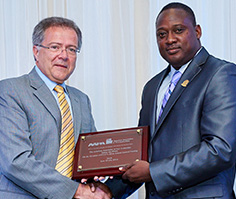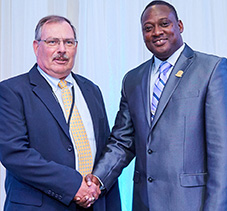
EDITORIAL
Ports united in dialogue and cooperation
The presence of the top leadership of both the American Association of Port Authorities (AAPA) and the Gulf Ports Association of the Americas (GPAA) at the 2016 Annual General Meeting of the Port Management Association of the Caribbean (PMAC) in Nevis was historically significant for more than the fact that this never happened before.
The presence of both the Chair and the President of the AAPA as well as the Chair of the GPAA, seated with the members and associate members of PMAC, as well as representatives of the International Maritime Organization (IMO), the Caribbean Development Bank (CDB) and the Organization of Eastern Caribbean States (OECS) was indicative of a new era of dialogue. and cooperation. The fact that they all travelled to remote Nevis to discuss Ports United for the Future, among other topics, did suggest that this was the start of a new era of cooperation.


A capable and efficient seaport with an attitude for sustainability can drive national development. By contrast, under-developed, sub-standard and inefficient seaports, especially in island-states, will retard and even reverse development. And an unsecured and poorly managed seaport can be a source of problems for other port operations to which it is linked in the supply chain. It is therefore in everyone’s interest that seaports identify, share, adopt and implement best, most successful practices. This process of transfer is readily facilitated by dialogue and a willingness to cooperate.
Frameworks for meaningful cooperation
The formal Memorandum of Understanding between the PMAC and the AAPA; and that between the PMAC and the GPAA, provide frameworks for meaningful cooperation. And the dialogue which gave rise to the signing of both documents was taken to a new level in Nevis. (link page 6). This is significant.

Caribbean seaports, because their cargo operations support directly the industrial and agricultural sectors, are vitally important for national economic survival let alone growth. However, in addition to cargo ships, many ports or port authorities also have portfolio responsibilities for receiving, facilitating or providing services for yachts and pleasure craft.
Cruise ports and marinas
Significant capital investments across the Caribbean region have been made in developing and maintaining facilities to accommodate cruise ships, yachts and smaller pleasure craft. The Caribbean is often described as ‘the cruise capital of the world’ and is acknowledged globally as having the most robust cruise ship business on the planet. But, the Caribbean is also a leading yacht charter destination and is one of the top jurisdictions for the registration of superyachts and megayachts in the world.
Revenues from the yachting sub-sector are not inconsequential and Caribbean destinations are waking to this reality. New marinas are being constructed across the region. Existing marinas are expanding or upgrading their services and facilities. Cruise ports are in upgrade mode or have recently completed expansion work.
Many Caribbean territories have the natural setting to accommodate, in protected seclusion, some of the world’s finest yachts. []
- First published November 1, 2016






